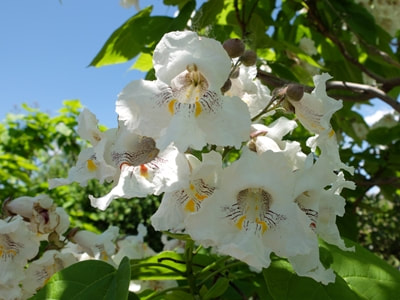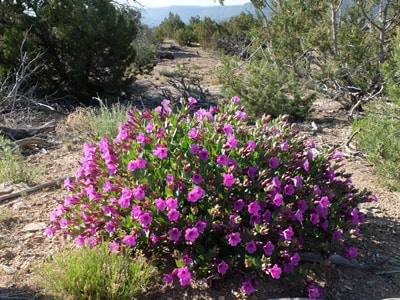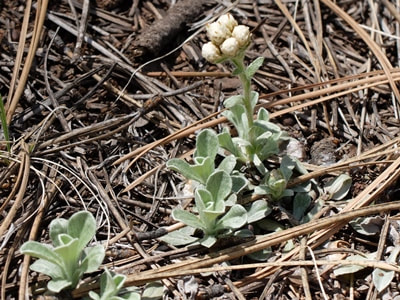|
The Bloom Blog Blooming this week in the environs of Abiquiú By Wildflowers of the Southern Rocky Mountains Found in roadsides, clearings, yards
Seen blooming in June near Hwy 554 Northern Catalpa is native to the mid-West but it has been widely planted in urban areas as a street tree and lawn tree as it grows in moist low spots or dry areas with poor soils. The name ‘catalpa’ comes from the Cherokee Indian name for the tree. It grows 40 to 60 feet tall, with a narrow, open, irregularly rounded crown and spreading branches. Its bark is brownish-gray becoming ridged with age. It has large, heart-shaped leaves and pyramid-shaped clusters of fragrant, showy flowers. Flowers are large, over 2 inches long, white and bell-shaped with ruffled edges and orange stripes and purple spots and stripes inside. The long, bean-like seed pods are 8 to 18 inches long, turn brown and persist through the winter. European settlers planted the tree to produce fence posts. Railroad companies grew plantations of it for use as track ties and fuel wood. Carpenters commonly used it for interior trim and to make furniture. The seed pods are not toxic but have no culinary use. Pioneer doctors used the seed pods and seeds to make a decoction for chronic bronchial infections, spasmodic asthma, labored breathing and heart problems. The juice from either the leaves or roots was used to treat swelling of an eye or cutaneous affections. Green leaves were crushed and placed on swollen lymph glands. Source. If you are trying to identify a different flower then you can check what other flowers bloom this month. If you cannot identify a flower from the website, send a photo and where you took it to contact@rockymountainsflora.com. Read online for tips.
0 Comments
The Bloom Blog Blooming this week in the environs of Abiquiú By Wildflowers of the Southern Rocky Mountains Found in sandy, disturbed areas, roadsides, under old junipers
Seen blooming in June by FS Road 23, Carson NF Showy Four O'clock is a magnificent native wildflower that blooms all summer and into the fall. The Latin name, Mirabilis multiflora, translates to "marvelous multi-flowered plant", which is a fitting description. Stems spread to two feet tall and six feet across forming a mound of soft, heart-shaped leaves and flowers. Magenta-pink flowers are funnel-like, up to three inches long, opening in the evening for pollination by hawkmoths, and closing the next morning, unless it is cloudy. Showy Four O'clock has become a popular xeriscape plant in southwestern gardens. It requires little supplemental water once established and needs plenty of space or it will smother adjacent plants. Native Americans used the root in the treatment of stomach complaints; to relieve hunger and after overeating to relieve the discomfort. It was used as an antiseptic to wash out wounds in horses and a poultice of the powdered root applied to swellings. Source. If you are trying to identify a different flower then you can check what other flowers bloom this month. If you cannot identify a flower from the website send a photo and where you took it to contact@rockymountainsflora.com. Read online for tips. The Bloom Blog Blooming this week in the environs of Abiquiú By Wildflowers of the Southern Rocky Mountains Found in dry meadows, slopes, dry coniferous forests
Seen blooming in late May by FS Rd 137, Carson NF The flower heads of the Antennaria genus grow in a tightly packed cluster which, from above, resemble a cat's paw, from below, so it was given the common name of Pussytoes. Small-leaf Pussytoes grows to four inches high, usually less, from a mat of small, grey-green leaves. Flower heads of two to seven flowers appear when stems are only two inches high. Traditionally it was used to treat swellings, chewed with deer or sheep tallow as a blood purifier, taken for the mad coyote bite, a cold infusion of the root was taken as protection against witches, and the young leaves were used as greens. Source. If you are trying to identify a different flower then you can check what other flowers bloom this month. If you cannot identify a flower from the website, send a photo and where you took it to contact@rockymountainsflora.com. Read online for tips. |
AuthorI am Marilyn Phillips, a native of England, whose love of nature and the outdoors from childhood brought me by a circuitous route to Crested Butte, Colorado in 1993 and 16 years later to northern New Mexico. My exploration of the many trails in these areas, my interest in wildflowers and photography, and career in computer system design came together in this creation. If you have any corrections, comments or questions, please contact me by email. Archives
June 2025
Categoriescopyright © 2020
|





 RSS Feed
RSS Feed